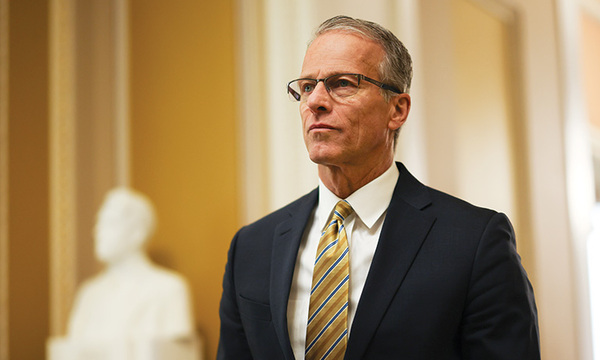For decades, churches across America have watched attendance shrink and spiritual affiliation decline. But new data shows signs of a recent rise in spiritual hunger ‚ÄĒ pointing to the possibility of renewal, says Ed Stetzer, dean of Biola‚Äôs Talbot School of Theology.
With fresh research in hand and a custom-branded van on the road, Stetzer is crisscrossing the country this year on his ‚ÄúLead the Way Tour,‚ÄĚ bringing insights and encouragement to thousands of ministry leaders from California to Florida. At each stop, he‚Äôs unpacking findings from the State of the Church 2025 initiative, a major study from Gloo and Barna Group, a prominent research firm led by Biola trustee David Kinnaman (B.A. ‚Äô96). Along the way, he‚Äôs engaging leaders and guest experts in honest conversations about the challenges and opportunities facing the church today.
Biola Magazine caught up with Stetzer between tour stops to ask him about the research and its implications for the church today.
We‚Äôve been hearing for many years about the steady rise of the ‚Äúnones‚ÄĚ ‚ÄĒ people who aren‚Äôt affiliated with any religion. What does the latest data reveal about that trend?
The big news is that the rise of the nones has actually plateaued. That doesn‚Äôt mean it has reversed, but when something that‚Äôs a 30-year trend changes, it‚Äôs worth our attention. Every year for the last 30 years, about 1% less Americans called themselves Christians and 1% more Americans said they were nothing. We call that the rise of the nones or the none-of-the-aboves. It‚Äôs been pretty stunning ‚ÄĒ the rise of secular thinking and the decline of Christian identification for the last several decades. But the last few years has seemed to lead to a pause to that. In some of my writings, this is what I call the ‚Äúmeteor of 2020.‚ÄĚ So many things have changed in religion research since 2020. If the news wasn‚Äôt a never-ending cycle of craziness, I think some of the shifts in religion in the last few years would be on the front page of a lot of major newspapers.
What’s the most surprising finding to emerge from the State of the Church research?
For the first time in the history of religion research in America, more young men in Gen Z are attending church than young women. This is a very significant trend. If you follow the cultural realities, there‚Äôs a crisis of young men in our nation. And some of them in the midst of that crisis are turning to faith. Now, don‚Äôt misunderstand ‚ÄĒ there are many more turning to many other things ‚ÄĒ seen in the rise of people like Andrew Tate and his version of ungodly masculinity. And far more young men are probably being influenced by Joe Rogan than by an older man discipling them in their local church. (And note, I don‚Äôt put them in the same category.) But my point is, I‚Äôd rather have young men being discipled in their churches than by Jordan Peterson‚Äôs books. So, what most surprises me is the return of some of these young men to church.
Now, there’s a downside: Yes, some young men are coming back to church, but one of the reasons that more young men than young women are going to church is more young women are dropping out of church. And we need to ask questions about why, and how we should engage them. Because this is such a huge shift. For decades upon decades, it’s been true that women have been the backbone of the church, and they still are, but for Gen Z something different is going on.
What’s one key takeaway you’re hoping pastors and ministry leaders gain from your tour stops?
I often say the moment we‚Äôre in doesn‚Äôt pause the mission we‚Äôre on. As I look at the current situation, the bigger picture has to be seen as one of decline. Religion in America has been declining for decades. But there‚Äôs been a pause, and in some ways, there‚Äôs been an uptick. One of the things that David Kinnaman‚Äôs data is showing at Barna Group is that self-reported church attendance has ticked up a little bit. It‚Äôs still lower than what it was 10 years ago, but I think that we‚Äôre at an opportunity. We see young men returning to church. We see a greater spiritual openness in young people, and even older people ‚ÄĒ a greater spiritual openness since the pandemic. I think the meteor crash of 2020 has changed so many things. It‚Äôs a gospel opportunity, and I‚Äôm hoping pastors and ministry leaders will learn from the current situation and seize the gospel moment that‚Äôs there.
Your Lead the Way Tour has brought you to churches of all different sizes, denominations and demographics across the U.S. and beyond. What has stood out to you from this experience?
Well, I love the body of Christ. Just in this past week, I had the privilege of speaking to the new bishops of the Global Methodist Church. I‚Äôve had the privilege of engaging at a Presbyterian church that is liturgically driven. I‚Äôve had an opportunity to be at a typically nondenominational contemporary evangelical church. And I would say that God is using all different kinds of churches to reach all different kinds of people. I just recently did a meeting where we had several hundred pastors from all kinds of different churches, heads of school and ministry leaders come together. And they recognize that this pivotal moment we‚Äôre in requires us to walk together as those who share a common view of the gospel, and to encourage one another. To do what the writer of Hebrews says, to provoke one another to love and good deeds. To join in common evangelistic and service projects together. To encourage others to be about church planting and more. So, what has stood out to me: Right now, I think the body of Christ sees ‚ÄĒ and needs to seize ‚ÄĒ this critical moment. And I‚Äôm actually somewhat encouraged that we will.
Follow Along. Ed Stetzer’s Lead the Way Tour has taken him to churches in California, Florida, Hawaii, Oregon, Washington, Texas and beyond, with more events on the way. Learn more about the tour, explore the research and find resources at biola.edu/leadtheway.
 ņ∂›ģ ”∆Ķ
ņ∂›ģ ”∆Ķ




